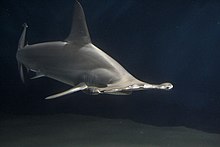Sensory systems in fish
[9] Hearing is well-developed in carp, which have the Weberian organ, three specialized vertebral processes that transfer vibrations in the swim bladder to the inner ear.
[10] A small opening on each side of their heads (not the spiracle) leads directly into the inner ear through a thin channel.
[citation needed] The lateral line in fish and aquatic forms of amphibians is a detection system of water currents, consisting mostly of vortices.
Afferent nerve fibers are excited or inhibited depending on whether the hair cells they arise from are deflected in the preferred or opposite direction.
Lateral line neurons form somatotopic maps within the brain informing the fish of amplitude and direction of flow at different points along the body.
These maps are located in the medial octavolateral nucleus (MON) of the medulla and in higher areas such as the torus semicircularis.
[13] Pressure detection uses the organ of Weber, a system consisting of three appendages of vertebrae transferring changes in shape of the gas bladder to the middle ear.
Many larger catfish have chemoreceptors across their entire bodies, which means they "taste" anything they touch and "smell" any chemicals in the water.
[16] In 1978, Hasler and his students convincingly showed that the way salmon locate their home rivers with such precision was indeed because they could recognise its characteristic smell.
[17][18][19] Homecoming salmon can also recognise characteristic smells in tributary streams as they move up the main river.
[17][20] Sharks have keen olfactory senses, located in the short duct (which is not fused, unlike bony fish) between the anterior and posterior nasal openings, with some species able to detect as little as one part per million of blood in seawater.
Some species, such as nurse sharks, have external barbels that greatly increase their ability to sense prey.
Some fish, such as catfish and sharks, have organs that detect weak electric potentials on the order of millivolts.
These fish make use of spectral changes and amplitude modulation to determine factors such shape, size, distance, velocity, and conductivity.
The paddlefish hunts plankton using thousands of tiny passive electroreceptors located on its extended snout, or rostrum.
The paddlefish is able to detect electric fields that oscillate at 0.5–20 Hz, and large groups of plankton generate this type of signal.
In 1988, researchers found iron, in the form of single domain magnetite, in the skulls of sockeye salmon.
After several years wandering huge distances in the ocean where they mature, most surviving salmons return to the same natal rivers to spawn.
[33] In 2003, Scottish scientists at the University of Edinburgh and the Roslin Institute concluded that rainbow trout exhibit behaviors often associated with pain in other animals.
Rose had published a study a year earlier arguing that fish cannot feel pain because their brains lack a neocortex.
"[36] Animal welfare advocates raise concerns about the possible suffering of fish caused by angling.





